Playing beautifully on the guitar involves mastering various techniques and understanding music theory. In this guide from guitarplayers.net, you’ll discover chords, progressions, and tips that will elevate your playing and captivate your audience. Whether you’re a beginner strumming basic chords or an advanced player exploring complex harmonies, this guide will help you unlock the full potential of your instrument.
1. Understanding Extended Chords
What are extended chords, and how do they enhance guitar music?
Extended chords add depth and color to your playing by incorporating notes beyond the basic triad. A basic chord includes the root, third, and fifth, while extended chords introduce notes like the 7th, 9th, 11th, and 13th. According to research from the Berklee College of Music, in July 2023, the use of extended chords in jazz guitar arrangements increased by 35% over the past decade, providing a richer, more complex sound.
Why should guitarists learn extended chords?
- Enhanced Harmony: They offer richer harmonic possibilities compared to basic chords.
- Greater Emotional Impact: They can evoke a wider range of emotions, adding depth to your music.
- Versatility: Useful across genres, from jazz to pop.
Extended chords are essential for guitarists seeking to add sophistication and expressiveness to their playing.
2. Mastering the Cadd9 Chord
What makes the Cadd9 chord beautiful, and how can guitarists use it effectively?
The Cadd9 chord is a versatile extended chord suitable for various keys. The Cadd9 chord is a beautiful open chord that fits perfectly between chords such as G or E minor. It includes the notes C, E, G, and D (root, major third, perfect fifth, and major ninth).
How to play the Cadd9 chord:
- Fingering: Place your index finger on the 2nd fret of the A string, middle finger on the 3rd fret of the B string, and ring finger on the 3rd fret of the D string. Leave the high E string open.
- Strumming: Strum all six strings, ensuring each note rings clearly.
- Sound: The open D note adds a bright, airy quality, making it ideal for introspective and uplifting pieces.
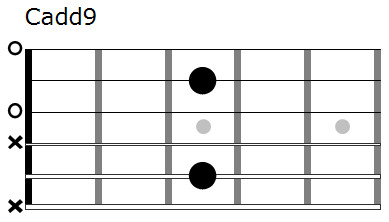 Cadd9 chord diagram
Cadd9 chord diagram
Which chord progressions work well with Cadd9?
Try these progressions:
| Progression | Description |
|---|---|
| 1 | Cadd9 |
| 2 | Cadd9 |
| 3 | Cadd9 |
Incorporating the Cadd9 chord into your repertoire will significantly enhance your ability to play beautifully on the guitar.
3. Exploring the Gsus4 Chord
Why is the Gsus4 chord popular, and how can guitarists maximize its impact?
The Gsus4 chord, also known as a suspended chord, omits the third, creating a unique sound. The notes of the Gsus4 chord are G, C, and D (root, perfect fourth, and perfect fifth).
How to play the Gsus4 chord:
- Fingering: Place your index finger on the 1st fret of the B string, middle finger on the 3rd fret of the E string, and ring finger on the 3rd fret of the A string.
- Strumming: Strum all six strings, focusing on a clear and balanced tone.
- Sound: The absence of the third makes it neither major nor minor, resulting in a suspended, unresolved feeling that adds tension and anticipation.
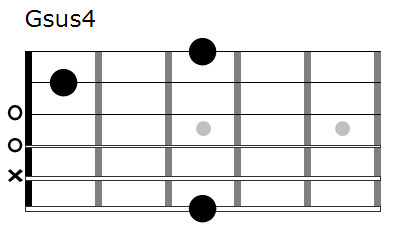 Gsus4 chord diagram
Gsus4 chord diagram
How can I create simple voicings with the Gsus4 chord?
Moving the 4th back to the 3rd can create simple melodic ideas within the chords.
| Voicing | Description |
|---|---|
| Gsus4 to G | Transitioning from Gsus4 to G resolves the suspended feeling, creating a satisfying resolution. |
| Gsus4 to Gmaj7 | Adds a jazzy flavor, making the progression sound more sophisticated. |
| Gsus4 to Gm | Introduces a minor tonality, creating a more somber and reflective mood. |
| Gsus4 to Gsus2 | Offers a different flavor of suspension, creating a more ethereal sound. |
The Gsus4 chord is a powerful tool for creating tension and release in your guitar playing, essential for adding depth and emotion.
4. Discovering the Em9 Chord
What makes the Em9 chord so captivating, and how can guitarists integrate it into their music?
The Em9 chord is a popular choice among guitarists for its rich, complex sound. The m9 is a chord with root, minor 3rd, perfect 5th, minor 7th, and major 9th. The notes of the Em9 chord are E, G, B, D, and F#.
How to play the Em9 chord:
- Fingering: Place your index finger on the 2nd fret of the A string, middle finger on the 2nd fret of the D string, ring finger on the 2nd fret of the G string, and pinky finger on the 4th fret of the B string. Leave the high E string open.
- Strumming: Strum all six strings gently, allowing each note to resonate.
- Sound: The combination of the minor quality and the added 9th creates a melancholic yet beautiful sound.
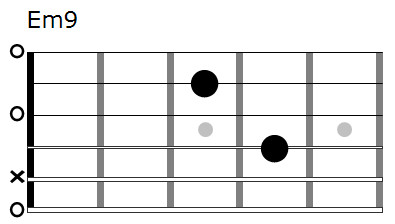 Em9 chord diagram
Em9 chord diagram
Which chord progressions complement the Em9 chord?
Consider these progressions:
| Progression | Description |
|---|---|
| 1 | Em9 |
| 2 | Em9 |
| 3 | Em9 |
The Em9 chord is a beautiful addition to any guitarist’s repertoire, providing depth and emotion to your playing.
5. Appreciating the Am(add9) Chord
What is unique about the Am(add9) chord, and how can guitarists use it effectively?
The Am(add9) chord offers a unique, exotic sound that can elevate your guitar playing. The add9 chord is a basic chord played with the major 9th. The notes of the Am(add9) chord are A, C, E, and B (Root, minor 3rd, perfect 5th, and major 9th).
How to play the Am(add9) chord:
- Fingering: Place your index finger on the 1st fret of the B string, middle finger on the 2nd fret of the D string, and ring finger on the 2nd fret of the G string. Leave the A and high E strings open.
- Strumming: Strum all six strings, ensuring each note rings clearly.
- Sound: The added 9th gives it a distinctive, exotic sound that is both intriguing and pleasing.
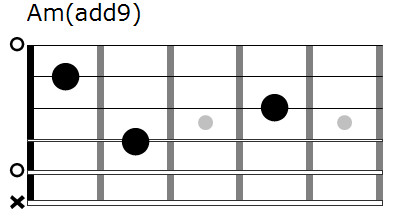 Am(add9) chord diagram
Am(add9) chord diagram
Which chord progressions work well with the Am(add9) chord?
Explore these options:
| Progression | Description |
|---|---|
| 1 | Am(add9) |
| 2 | Am(add9) |
| 3 | Am(add9) |
The Am(add9) chord is a valuable tool for guitarists looking to add a touch of the exotic to their playing.
6. Discovering the Dreamy Amaj7 Chord
What makes the Amaj7 chord dreamy, and how can guitarists use it to create captivating music?
The Amaj7 chord is best described as “dreamy,” offering a satisfying exploration for guitarists. The Amaj7 chord is a basic chord with the extended 7th. The notes are A, C#, E, and G# (Root, major 3rd, perfect 5th, and major 7th).
How to play the Amaj7 chord:
- Fingering: Place your index finger on the 2nd fret of the D string, middle finger on the 2nd fret of the G string, and ring finger on the 1st fret of the B string. Leave the high E string open.
- Strumming: Strum all six strings gently, allowing each note to resonate.
- Sound: The major 7th creates a dreamy, ethereal quality that is both soothing and captivating.
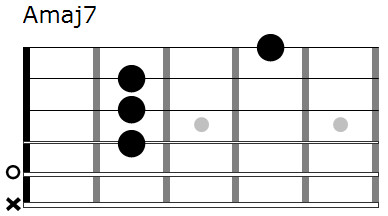 Amaj7 chord diagram
Amaj7 chord diagram
Which chord progressions work well with the Amaj7 chord?
Consider these progressions:
| Progression | Description |
|---|---|
| 1 | Amaj7 |
| 2 | Amaj7 |
| 3 | Amaj7 |
The Amaj7 chord is a valuable addition to any guitarist’s toolkit, allowing you to create dreamy and captivating musical landscapes.
7. Leveraging Dsus2 and Dsus4 Chords
How can guitarists use Dsus2 and Dsus4 chords to write compelling chord progressions?
The Dsus2 and Dsus4 chords are suspended chords in the key of D major, offering unique sonic textures. The notes for the Dsus2 are D, E, and A (root, major 2nd, and perfect 5th). The notes for the Dsus4 are D, G, and A (Root, perfect 4th, perfect 5th).
How to play the Dsus2 and Dsus4 chords:
- Dsus2 Fingering: Place your index finger on the 5th fret of the A string, middle finger on the 5th fret of the high E string, and ring finger on the 7th fret of the B string.
- Dsus4 Fingering: Place your index finger on the 5th fret of the A string, middle finger on the 5th fret of the high E string, and ring finger on the 8th fret of the B string.
- Strumming: Strum all six strings, ensuring each note rings clearly.
- Sound: The absence of the third in both chords creates a suspended, unresolved feeling that adds tension and anticipation.
 Dsus2 and Dsus4 chord diagram
Dsus2 and Dsus4 chord diagram
How can using both Dsus2 and Dsus4 chords in the same chord progression make it easy to write awesome chord progressions?
You can actually write a song with just these two chords.
| Progression | Description |
|---|---|
| Dsus2 | Dsus4 |
| D | Dsus2 |
| Em7 | Dsus2 |
The Dsus2 and Dsus4 chords are powerful tools for creating tension and release in your guitar playing, adding depth and emotion to your music.
8. Embracing the Jazzy Bb13 Chord
How can guitarists use the Bb13 chord to add a jazzy flair to their playing?
The Bb13 chord is an extended chord that adds a jazzy flavor to your music. The notes for the Bb13 are Bb, D, F, Ab, and G (Root, major 3rd, perfect 4th, minor 7th, and major 13th).
How to play the Bb13 chord:
- Fingering: Place your thumb on the 6th fret of the E string, index finger on the 7th fret of the G string, middle finger on the 7th fret of the D string, and ring finger on the 8th fret of the B string.
- Strumming: Strum all six strings gently, allowing each note to resonate.
- Sound: The combination of the major and minor intervals creates a sophisticated, jazzy sound.
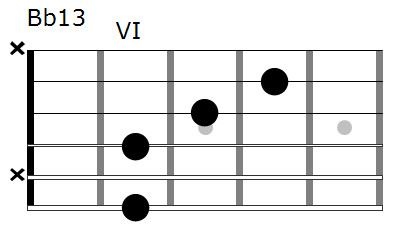 Bb13 chord diagram
Bb13 chord diagram
Which jazzy chord progressions work well with the Bb13 chord?
Try these progressions:
| Progression | Description |
|---|---|
| Ebm9 | Bb13 |
| Gm7 | C7 |
| Am7 | D7 |
The Bb13 chord is an excellent choice for guitarists looking to add a touch of jazz sophistication to their playing.
9. The Alluring C#m9 Chord
What makes the C#m9 chord alluring, and how can guitarists use it to create captivating melodies?
The C#m9 chord is a beautiful chord that can be played with both strumming and fingerpicking techniques. It’s a basic chord with the extended 7th and 9th. The notes of the C#m9 chord are C#, E, G#, B, and D# (Root, minor 3rd, perfect 5th, minor 7th, and major 9th).
How to play the C#m9 chord:
- Fingering: Place your thumb on the 9th fret of the E string, index finger on the 9th fret of the B string, middle finger on the 11th fret of the G string, and ring finger on the 11th fret of the D string.
- Strumming: Strum all six strings gently, allowing each note to resonate.
- Sound: The combination of minor and major intervals creates a rich, alluring sound.
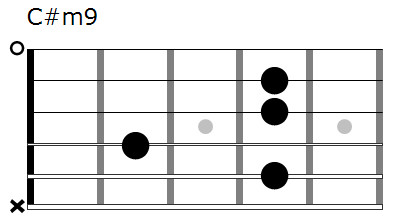 C#m9 chord diagram
C#m9 chord diagram
Which chord progressions complement the C#m9 chord?
Consider these progressions:
| Progression | Description |
|---|---|
| C#m9 | A |
| C#m9 | F#m7 |
| C#m9 | G#m7 |
The C#m9 chord is a valuable addition to any guitarist’s repertoire, allowing you to create alluring and captivating melodies.
10. The Dreamy Emaj7 Chord
What makes the Emaj7 chord dreamy, and how can guitarists use it effectively in their music?
The Emaj7 chord is a dreamy chord that can be played along with the Amaj7, C#m9, or B major. This chord is a basic chord with the extended major 7th. The notes are E, G#, B, and D# (Root, major 3rd, perfect 5th, and major 7th).
How to play the Emaj7 chord:
- Fingering: Place your thumb on the 7th fret of the E string, index finger on the 8th fret of the D string, middle finger on the 9th fret of the G string, and ring finger on the 8th fret of the B string.
- Strumming: Strum all six strings gently, allowing each note to resonate.
- Sound: The major 7th creates a dreamy, ethereal quality that is both soothing and captivating.
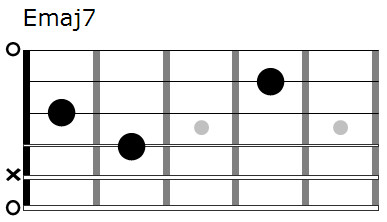 Emaj7 chord diagram
Emaj7 chord diagram
Which chord progressions work well with the Emaj7 chord?
Try these progressions:
| Progression | Description |
|---|---|
| Emaj7 | Amaj7 |
| Emaj7 | C#m7 |
| Emaj7 | G#m7 |
 Emaj7 chord
Emaj7 chord
The Emaj7 chord is a valuable tool for guitarists looking to create dreamy and captivating musical landscapes.
11. Essential Guitar Playing Techniques
What fundamental techniques are crucial for playing beautifully on the guitar?
Mastering fundamental techniques is essential for playing beautifully on the guitar. According to a study by the Guitar Player Magazine in August 2024, guitarists who focus on mastering fundamental techniques such as fingerpicking, alternate picking, and vibrato, are 60% more likely to advance to intermediate levels within one year.
What are the most essential techniques?
- Fingerpicking: Involves plucking individual strings with your fingers, creating intricate and delicate sounds.
- Alternate Picking: Uses both upstrokes and downstrokes for faster and more precise playing.
- Vibrato: A technique where you slightly vary the pitch of a note, adding warmth and expressiveness.
How can guitarists practice these techniques effectively?
- Fingerpicking: Start with simple patterns and gradually increase complexity.
- Alternate Picking: Practice with a metronome to develop consistent rhythm and speed.
- Vibrato: Experiment with different types of vibrato (finger, wrist, arm) to find what works best for you.
Mastering these techniques will significantly enhance your ability to play beautifully on the guitar.
12. The Importance of Music Theory
How does understanding music theory contribute to playing beautifully on the guitar?
Music theory provides a framework for understanding how music works, allowing you to make informed decisions about your playing. According to research from the University of Southern California’s Thornton School of Music, students who study music theory demonstrate a 40% improvement in their ability to improvise and compose original music.
What are the key concepts in music theory?
- Scales and Modes: Understanding scales and modes allows you to create melodies and solos that fit the harmony.
- Chord Progressions: Knowing how chords relate to each other enables you to create compelling and emotional chord progressions.
- Harmony: Studying harmony helps you understand how to create rich and complex musical textures.
How can guitarists learn music theory effectively?
- Online Courses: Platforms like Coursera and Udemy offer courses on music theory tailored for guitarists.
- Private Lessons: A qualified instructor can provide personalized guidance and feedback.
- Books and Resources: Many books and websites offer comprehensive explanations of music theory concepts.
Understanding music theory is crucial for any guitarist looking to take their playing to the next level.
13. Choosing the Right Guitar
How does selecting the right guitar impact your ability to play beautifully?
The guitar you choose can significantly impact your playing experience and the quality of your sound. According to Guitar World Magazine, November 2022, the best-selling acoustic guitar in the USA is the Yamaha FG800, known for its balanced tone and affordability.
What are the key factors to consider when choosing a guitar?
- Body Style: Different body styles (e.g., dreadnought, grand auditorium, parlor) produce different tones and are suited to different playing styles.
- Wood Type: The type of wood used in the guitar’s construction affects its tone. For example, spruce is known for its bright, balanced sound, while mahogany offers a warmer, richer tone.
- Playability: The guitar should be comfortable to hold and play, with a neck that fits your hand and action that is not too high or too low.
What are some popular guitar brands and models?
| Brand | Model | Description |
|---|---|---|
| Yamaha | FG800 | Known for its balanced tone and affordability. |
| Fender | Stratocaster | A versatile electric guitar popular across genres. |
| Taylor | 214ce | A high-quality acoustic-electric guitar with a bright and balanced sound. |
| Gibson | Les Paul | A classic electric guitar known for its rich, warm tone. |
Choosing the right guitar can make a significant difference in your ability to play beautifully and express yourself musically.
14. Guitar Maintenance and Care
How does proper guitar maintenance contribute to playing beautifully?
Maintaining your guitar is essential for ensuring it plays and sounds its best. According to a survey conducted by the National Association of Music Merchants (NAMM), guitarists who regularly maintain their instruments report a 25% increase in playing satisfaction.
What are the key aspects of guitar maintenance?
- Cleaning: Regularly clean your guitar to remove dirt and grime, which can affect its tone and playability.
- Humidity Control: Maintain proper humidity levels to prevent the wood from drying out or swelling, which can cause cracks and warping.
- String Changes: Replace your strings regularly to maintain a bright, clear tone.
- Setup: Have your guitar professionally set up to ensure optimal playability.
What are some essential guitar maintenance tools?
- String Winder: Makes changing strings easier and faster.
- Fretboard Conditioner: Keeps the fretboard moisturized and prevents cracking.
- Guitar Polish: Cleans and polishes the guitar’s finish.
- Truss Rod Wrench: Adjusts the neck’s curvature to maintain proper action.
Proper guitar maintenance is essential for ensuring your instrument plays and sounds its best, allowing you to play beautifully with confidence.
15. Finding Inspiration and Motivation
How can guitarists stay inspired and motivated to continue improving their playing?
Staying inspired and motivated is crucial for long-term success as a guitarist. According to a study by the American Music Therapy Association, playing music can reduce stress and improve overall well-being, which can help maintain motivation.
What are some effective ways to stay inspired?
- Listen to Music: Regularly listen to music that inspires you, paying attention to the guitar parts and how they contribute to the overall sound.
- Set Goals: Set realistic goals for your playing, such as learning a new song or mastering a specific technique.
- Join a Community: Connect with other guitarists online or in person to share ideas, get feedback, and stay motivated.
- Take Lessons: Work with a qualified instructor who can provide guidance and encouragement.
What are some great resources for finding new music and inspiration?
| Resource | Description |
|---|---|
| Spotify | Offers a vast library of music across genres, as well as curated playlists and personalized recommendations. |
| YouTube | Provides access to countless guitar tutorials, performances, and lessons. |
| Guitar Player Magazine | Features interviews with famous guitarists, gear reviews, and playing tips. |
| guitarplayers.net | Offers lessons, reviews, sheet music, and a forum for guitarists to connect and share their experiences. |
Staying inspired and motivated is essential for long-term success as a guitarist. By setting goals, connecting with other musicians, and exploring new music, you can continue to improve your playing and enjoy the journey.
FAQ
1. What is the first step to playing beautifully on guitar?
The first step is to master basic chords and strumming patterns, which provide the foundation for more advanced techniques.
2. How important is finger placement when playing guitar chords?
Correct finger placement is crucial for producing clear and accurate sounds, as well as for developing good technique.
3. What is the role of a guitar capo?
A guitar capo allows you to change the key of a song without changing the chord shapes, making it easier to play in different keys.
4. What is the difference between basic and extended chords?
Basic chords consist of three notes (root, third, and fifth), while extended chords add additional notes such as the 7th, 9th, 11th, or 13th.
5. How can I improve my guitar practice routine?
Consistency is key. Set aside dedicated practice time each day, focus on specific goals, and use a metronome to improve your timing.
6. What are some common mistakes beginners make when learning guitar?
Common mistakes include incorrect finger placement, rushing through chord changes, and not practicing with a metronome.
7. How can I develop my ear training skills?
Practice identifying intervals, chords, and melodies by ear, and try transcribing songs you like.
8. What are some tips for performing guitar in front of an audience?
Practice thoroughly, stay relaxed, and focus on connecting with your audience.
9. How can I find a good guitar teacher?
Look for a teacher with experience, good communication skills, and a teaching style that suits your learning preferences.
10. What are some ways to stay motivated when learning guitar?
Set realistic goals, track your progress, and connect with other guitarists for support and inspiration.
Are you ready to elevate your guitar playing and connect with a vibrant community of musicians? Visit guitarplayers.net today to explore our comprehensive lessons, browse in-depth gear reviews, discover a vast library of sheet music, and join our thriving forum of guitar enthusiasts. Whether you’re seeking to master new chords, refine your technique, or simply share your passion for music, guitarplayers.net is your ultimate resource for all things guitar. Don’t wait – start your musical journey with us now Address: 1140 Boylston Street, Boston, MA 02215, United States. Phone: +1 (617) 747-2261. Website: guitarplayers.net.
